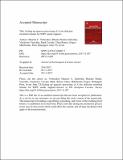Files in this item
Scaling up aqueous processing of A-site deficient strontium titanate for SOFC anode supports
Item metadata
| dc.contributor.author | Verbraeken, Maarten C. | |
| dc.contributor.author | Sudireddy, Bhaskar Reddy | |
| dc.contributor.author | Vasechko, Viacheslav | |
| dc.contributor.author | Cassidy, Mark | |
| dc.contributor.author | Ramos, Tânia | |
| dc.contributor.author | Malzbender, Jürgen | |
| dc.contributor.author | Holtappels, Peter | |
| dc.contributor.author | Irvine, John T. S. | |
| dc.date.accessioned | 2018-11-29T00:49:22Z | |
| dc.date.available | 2018-11-29T00:49:22Z | |
| dc.date.issued | 2018-04 | |
| dc.identifier | 251665934 | |
| dc.identifier | 629595ca-1160-4898-bf14-d36e5b6b1c00 | |
| dc.identifier | 85037044082 | |
| dc.identifier | 000424716700083 | |
| dc.identifier.citation | Verbraeken , M C , Sudireddy , B R , Vasechko , V , Cassidy , M , Ramos , T , Malzbender , J , Holtappels , P & Irvine , J T S 2018 , ' Scaling up aqueous processing of A-site deficient strontium titanate for SOFC anode supports ' , Journal of the European Ceramic Society , vol. 38 , no. 4 , pp. 1663-1672 . https://doi.org/10.1016/j.jeurceramsoc.2017.11.057 | en |
| dc.identifier.issn | 0955-2219 | |
| dc.identifier.other | RIS: urn:00FE7F3A48960A32F59224561BC51D77 | |
| dc.identifier.other | ORCID: /0000-0002-8394-3359/work/68280659 | |
| dc.identifier.uri | https://hdl.handle.net/10023/16571 | |
| dc.description | The authors gratefully acknowledge funding from the Fuel Cells and Hydrogen Joint Undertaking under grant agreement n° 256730. | en |
| dc.description.abstract | All ceramic anode supported half cells of technically relevant scale were fabricated in this study, using a novel strontium titanate anode material. The use of this material would be highly advantageous in solid oxide fuel cells due to its redox tolerance and resistance to coking and sulphur poisoning. Successful fabrication was possible through aqueous tape casting of both anode support and electrolyte layers and subsequent lamination. Screen printing of electrolyte layers onto green anode tapes was also attempted but resulted in cracked electrolyte layers upon firing. Microstructural, electrical and mechanical properties of anode supports and half cells will be discussed. The use of two different commercial titanate powders with nominal identical, but in reality different stoichiometries, strongly affect electrical and mechanical properties. Careful consideration of such variations between powder suppliers, and batches of the same supplier, is critical for the successful implementation of ceramic anode supported solid oxide fuel cells. | |
| dc.format.extent | 2461469 | |
| dc.language.iso | eng | |
| dc.relation.ispartof | Journal of the European Ceramic Society | en |
| dc.subject | Solid oxide fuel cells | en |
| dc.subject | Alternative anodes | en |
| dc.subject | Perovskites | en |
| dc.subject | Tape casting | en |
| dc.subject | Co-firing | en |
| dc.subject | QD Chemistry | en |
| dc.subject | NDAS | en |
| dc.subject.lcc | QD | en |
| dc.title | Scaling up aqueous processing of A-site deficient strontium titanate for SOFC anode supports | en |
| dc.type | Journal article | en |
| dc.contributor.sponsor | European Commission | en |
| dc.contributor.institution | University of St Andrews. School of Chemistry | en |
| dc.contributor.institution | University of St Andrews. EaSTCHEM | en |
| dc.identifier.doi | https://doi.org/10.1016/j.jeurceramsoc.2017.11.057 | |
| dc.description.status | Peer reviewed | en |
| dc.date.embargoedUntil | 2018-11-29 | |
| dc.identifier.grantnumber | 256730 256730 | en |
This item appears in the following Collection(s)
Items in the St Andrews Research Repository are protected by copyright, with all rights reserved, unless otherwise indicated.

